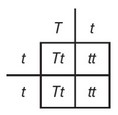Question
Sickle cell disease is an autosomal recessive disorder. Homozygous recessive individuals have red blood cells that can assume a sickle
shape when oxygen levels are low. These sickled blood cells can cause blockages in blood vessels, leading to pain and possibly fatal
complications. Heterozygous individuals do not suffer the pain or complications from sickle cell disease and are more resistant to
malaria than individuals with two nonsickle alleles. The following figure shows the pattern of inheritance of sickle cell disease through
three generations of a family. Squares indicate males, circles indicate females, and shaded shapes indicate individuals who have sickle cell
disease.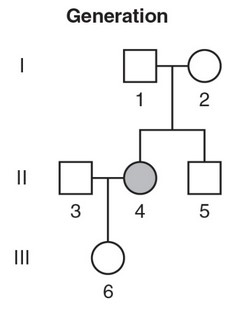
(a) Describe the genotype of individual I-2. Justify your answer with evidence from the pedigree.
(b) What is the genotype of individual III-6? Explain how you know her genotype.
(c) Create a Punnett square that represents the possible genotypes of the offspring of individuals 1 and 2 from generation I.
(d) Explain which genotype from this pedigree would provide an advantage in San Francisco (where the mosquito that carries
malaria does not live) and which genotype would be most advantageous to survival in Haiti (where the mosquito that carries
malaria is found).
▶️Answer/Explanation
Ans:
(a) Individual I-2 is heterozygous for sickle cell. This is true because
she does not have sickle cell disease (so she cannot have the ss
genotype), but she has a child who has sickle cell disease. So
individual I-2 must be a carrier of the allele (Ss).
(b) Individual III-6 in must be heterozygous. This is true because she
does not have sickle cell disease, so she must have at least one S
allele, and since one of her parents (individual II-4) does have
sickle cell disease, she must have inherited a copy of the s allele
from that parent
(c) 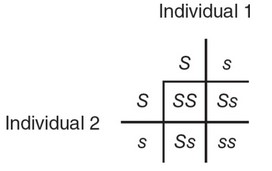
(d) Since there is no malaria in San Francisco, the SS genotype would
be most advantageous because those individuals would not have
sickle cell disease. In Haiti, due to the presence of malaria, the
heterozygous genotype (Ss) would be the most advantageous
because individuals with that genotype would not have sickle cell
disease but would also be resistant to malaria.
Question
Fur color in hamsters is determined by a single gene, with yellow fur color being dominant to white fur color. Inheriting two copies of the
allele for yellow fur color is fatal, so all individuals with yellow fur are heterozygous.
(a) Determine the probability that the offspring of two hamsters with yellow fur would also have yellow fur.
(b) Construct a Punnett square that represents the two hamster parents from part (a), and use the Punnett square to explain your answer to part (a).
(c) A hamster population lives in an area covered with yellow- goldenrod-colored grasses. An unusually cold winter results in the death of all the yellow-goldenrod-colored grasses, so in the spring the area is covered only in white sand. Predict what would happen to the frequency of the allele for yellow fur color over time.
(d) Justify your prediction from part (c).
▶️Answer/Explanation
Ans:
(a) The probability of producing a hamster offspring with yellow fur would be \(\frac{2}{3}\).
(b) As shown in the following Punnett square, both parents must be
heterozygous, so the possible genotypes are YY, Yy, or yy. However,
since YY is always fatal as per the information stated in the
question, there are only two possible outcomes for live offspring:
Yy or yy. So \(\frac{2}{3}\) would be heterozygous for yellow fur, and \(\frac{1}{3}\) would have white fur.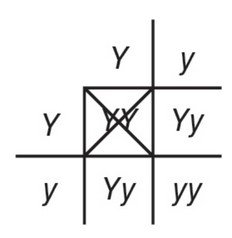
(c) The frequency of the yellow allele would probably decrease over
time.
(d) Hamsters with white fur color would be better able to blend in with
the white sand environment and more likely to hide from potential
predators than hamsters with yellow fur. Thus, the frequency of the
yellow allele would likely decrease over time.
Question
In pea plants, tall plant height is dominant over short. A new type of plant food (Supersize Food) is advertised to increase plant height. Two
pea plants that are heterozygous for plant height are crossed, and the seeds that are produced are harvested. Half of the seeds are planted and
grown in the presence of Supersize Food, and the other half of the seeds are planted and grown without Supersize Food. When the plants
reach full maturity, the number of tall and short plants are recorded.
The data are shown in the table.
Number of Tall and Short Pea Plants Grown in the Absence or Presence of Supersize Food
| Height of Plant | Plants Grown Without Supersize Food | Plants Grown with Supersize Food |
| Tall | 1,290 | 1,265 |
| Short | 430 | 455 |
(a) Describe the proportions of tall and short plants that were expected to result from the cross. Use a Punnett square to support your answer.
(b) Identify the independent variable and the dependent variable in this experiment. Identify one possible appropriate experimental constant.
(c) A student makes the claim that “there is no statistically significant difference between the plants grown in the presence or absence of
Supersize Food.” Use the chi-square equation to analyze the data and evaluate this claim. Use a p-value of 0.05 for your analysis.
(d) A tall plant with an unknown genotype is crossed with a short plant. Predict the expected proportions of tall and short offspring if the tall plant is heterozygous. Justify your prediction.
▶️Answer/Explanation
Ans:
(a) If both of the parental plants in the cross are heterozygous, one
would expect \(\frac{3}{4}\) of the progeny to be tall and \(\frac{1}{4}\) of the progeny to be short. TT and Tt plants would be tall, and tt plants would be short.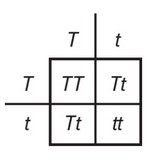
(b) The independent variable is the presence or absence of Supersize
Food. The dependent variable is the number of plants that are tall
or short. One appropriate constant might be the amount of light the
plants were exposed to. Other appropriate constants include the
amount of water the plants were given or the type of soil the plants
were grown in.
(c) Using the chi-square equation:
\(x^2 = \frac{(1,265-1,290)^2}{1,290}+\frac{(455-430)^2}{430}=\frac{625}{1,290} +\frac{625}{430} = 1.94\)
There are tow possible outcomes in the experiment (tall or short), so there is one degree of freedom (df = number of possible outcomes – 1). Using a p-value of 0.05 and the chi-square table, the critical value is 3.84. The calculated chi-square value of 1.94 is less than the critical value. So it fails to reject the null hypothesis, and thus the student’s claim is supported.
(d) A test cross is when an organism with the dominant trait (but an
unknown genotype) is crossed with an organism with the recessive
phenotype. If the tall plant is heterozygous and is crossed with a
short plant (the recessive phenotype), half of the offspring would
be tall and half would be short, as shown in this Punnett square.